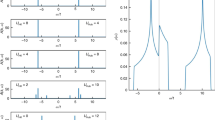Abstrtact
The Fermi liquid approach is applied to the problem of spontaneous violation of the C 4 symmetry in strongly correlated two-dimensional electronic systems on a square lattice. The symmetry breaking is traced to the existence of a topological phase transition. This continuous transition is triggered when the Fermi line, driven by the quasiparticle interactions, reaches the van Hove saddle points, where the group velocity vanishes and the density of states becomes singular. An unconventional Fermi liquid emerges beyond the implicated quantum critical point.
Similar content being viewed by others
References
A. Kaminski, S. Rosenkranz, H. W. Fretwell, et al., Nature 416, 610 (2002).
Y. Ando, K. Segawa, S. Komiya, and A. N. Lavrov, Phys. Rev. Lett. 88, 137005 (2002).
J. Xia, E. Schemm, G. Deutscher, et al., Phys. Rev. Lett. 100, 127002 (2008).
V. Hinkov, D. Haug, B. Fauque, et al., Science 319, 597 (2008).
H. A. Mook, Y. Sidis, B. Fauque, et al., Phys. Rev. B 78, 020506(R) (2008).
K. Daou, J. Chang, D. LeBoeuf, et al., arXiv:0909.4430.
S. A. Kivelson, E. Fradkin, and V. J. Emery, Nature 393, 550 (1998).
H. Yamase and H. Kohno, J. Phys. Soc. Jpn. 69, 2151 (2000).
C. J. Halboth and W. Metzner, Phys. Rev. Lett. 85, 5162 (2000).
I. Ya. Pomeranchuk, Sov. Phys. JETP 8, 361 (1959).
V. Oganesyan, S. A. Kivelson, and E. Fradkin, Phys. Rev. B 64, 195109 (2001).
A. P. Kampf and A. A. Katanin, Phys. Rev. B 67, 125104 (2003).
A. Neumayr and W. Metzner, Phys. Rev. B 67, 035112 (2003).
H. Y. Kee, E. H. Kim, and C. H. Chung, Phys. Rev. B 68, 245109 (2003).
H. Yamase and W. Metzner, Phys. Rev. B 75, 155117 (2007).
C. A. Lamas, D. C. Cabra, and N. Grandi, Phys. Rev. B 78, 115104 (2008).
E. Fradkin, S. A. Kivelson, M. J. Lawler, et al., arXiv:0910.4166.
S. T. Belyaev, Mat. Fys. Medd. K. Dan. Vidensk. Selsk. 31(11), 1 (1959).
I. Khavkine, C. Chang, V. Oganesyan, and H. Kee, Phys. Rev. B 70, 155110 (2004).
A. B. Migdal, Theory of Finite Fermi Systems and Applications to Atomic Nuclei (Wiley, New York, 1967).
I. M. Lifshitz, Sov. Phys. JETP 11, 1130 (1960).
V. A. Khodel and V. R. Shaginyan, JETP Lett. 51, 553 (1990).
G. E. Volovik, JETP Lett. 53, 222 (1991).
P. Noziéres, J. Phys. I France 2, 443 (1992).
M. V. Zverev and M. Baldo, JETP 87, 1129 (1998); J. Phys.: Condens. Matter 11, 2059 (1999).
S. A. Artamonov, V. R. Shaginyan, and Yu. G. Pogorelov, JETP Lett. 68, 942 (1998).
M. V. Zverev, V. A. Khodel, and J. W. Clark, JETP Lett. 74, 46 (2001).
J. Quintanilla and A. J. Schofield, Phys. Rev. B 74, 115126 (2006).
V. A. Khodel, J. W. Clark, H. Li, and M. Zverev, Phys. Rev. Lett. 98, 216404 (2007).
G. E. Volovik, Lecture Notes in Physics 718, 31 (2007) [cond-mat/0601372].
V. R. Shaginyan, M. Ya. Amusia, and K. G. Popov, Usp. Fiz. 177, 585 (2007) [Phys. Usp. 50, 563 (2007)].
V. A. Khodel, J. W. Clark, and M. V. Zverev, Phys. Rev. B 78, 075120 (2008), and references therein.
V. A. Khodel, J. W. Clark, and M. V. Zverev, JETP Lett. 87, 693 (2009); arXiv:0904.1509.
L. D. Landau, Sov. Phys. JETP 3, 920 (1957); Sov. Phys. JETP 5, 101 (1957); Sov. Phys. JETP 8, 70 (1959).
L. D. Landau and E. M. Lifshitz, Course of Theoretical Physics, Vol. 5: Statistical Physics, 3rd ed. (Nauka, Moscow, 1976; Addison-Wesley, Reading, MA, 1970).
D. Pines, Physica C 282–287, 273 (1997); A. V. Chubukov, Europhys. Lett. 44, 655 (1998).
Author information
Authors and Affiliations
Corresponding author
Additional information
The article is published in the original.
Rights and permissions
About this article
Cite this article
Zverev, M.V., Clark, J.W., Nussinov, Z. et al. Spontaneous breaking of four-fold rotational symmetry in two-dimensional electronic systems explained as a continuous topological transition. Jetp Lett. 91, 529–534 (2010). https://doi.org/10.1134/S0021364010100085
Received:
Published:
Issue Date:
DOI: https://doi.org/10.1134/S0021364010100085




